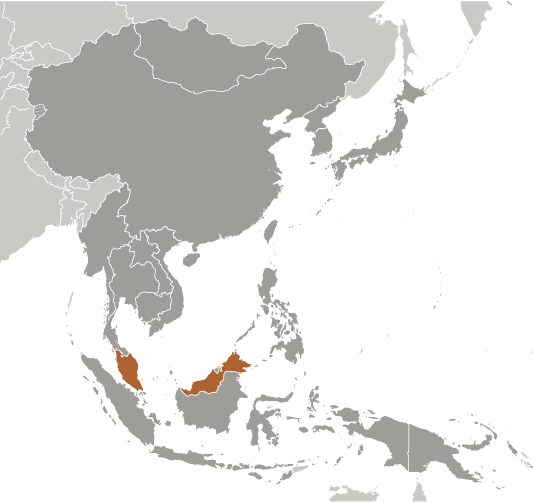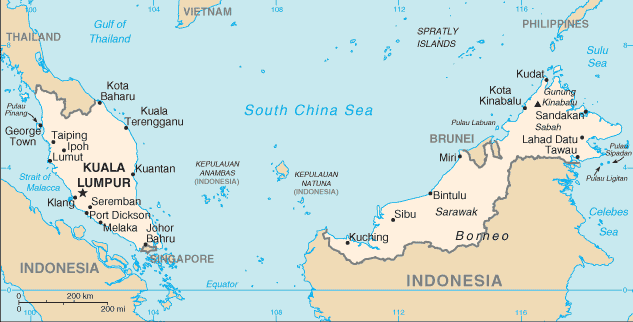|
Economy - overview:
|

|
|
Malaysia, a middle-income country, has transformed itself since the 1970s from a producer of raw materials into an emerging multi-sector economy. Under current Prime Minister NAJIB, Malaysia is attempting to achieve high-income status by 2020 and to move farther up the value-added production chain by attracting investments in Islamic finance, high technology industries, biotechnology, and services. NAJIB's Economic Transformation Program (ETP) is a series of projects and policy measures intended to accelerate the country's economic growth. The government has also taken steps to liberalize some services sub-sectors. The NAJIB administration also is continuing efforts to boost domestic demand and reduce the economy's dependence on exports. Nevertheless, exports - particularly of electronics, oil and gas, palm oil and rubber - remain a significant driver of the economy. As an oil and gas exporter, Malaysia has profited from higher world energy prices, although the rising cost of domestic gasoline and diesel fuel, combined with strained government finances, has forced Kuala Lumpur to begin to reduce government subsidies. The government is also trying to lessen its dependence on state oil producer Petronas. The oil and gas sector supplies about 35% of government revenue in 2011. Bank Negera Malaysia (central bank) maintains healthy foreign exchange reserves, and a well-developed regulatory regime has limited Malaysia's exposure to riskier financial instruments and the global financial crisis. Nevertheless, Malaysia could be vulnerable to a fall in commodity prices or a general slowdown in global economic activity because exports are a major component of GDP. In order to attract increased investment, NAJIB has raised possible revisions to the special economic and social preferences accorded to ethnic Malays under the New Economic Policy of 1970, but he has encountered significant opposition, especially from Malay nationalists and other vested interests.
|
|
|
GDP (purchasing power parity):
|

|
|
$492.4 billion (2012 est.)
country comparison to the world: 30
$471.2 billion (2011 est.)
$448.4 billion (2010 est.)
note:
data are in 2012 US dollars
|
|
|
GDP (official exchange rate):
|

|
|
$307.2 billion (2012 est.)
|
|
|
GDP - real growth rate:
|

|
|
4.5% (2012 est.)
country comparison to the world: 72
5.1% (2011 est.)
7.2% (2010 est.)
|
|
|
GDP - per capita (PPP):
|

|
|
$16,900 (2012 est.)
country comparison to the world: 79
$16,500 (2011 est.)
$15,900 (2010 est.)
note:
data are in 2012 US dollars
|
|
|
GDP - composition by sector:
|

|
|
agriculture: 11.9%
industry:
41.2%
services:
46.8% (2012 est.)
|
|
|
Labor force:
|

|
|
12.92 million (2012 est.)
country comparison to the world: 42
|
|
|
Labor force - by occupation:
|

|
|
agriculture: 11.1%
industry:
36%
services:
53.5% (2012 est.)
|
|
|
Unemployment rate:
|

|
|
3.2% (2012 est.)
country comparison to the world: 27
3.1% (2011 est.)
|
|
|
Population below poverty line:
|

|
|
3.8% (2009 est.)
|
|
|
Household income or consumption by percentage share:
|

|
|
lowest 10%: 1.8%
highest 10%:
34.7% (2009 est.)
|
|
|
Distribution of family income - Gini index:
|

|
|
46.2 (2009)
country comparison to the world: 33
49.2 (1997)
|
|
|
Investment (gross fixed):
|

|
|
25.2% of GDP (2012 est.)
country comparison to the world: 50
|
|
|
Budget:
|

|
|
revenues: $59.22 billion
expenditures:
$75.31 billion (2012 est.)
|
|
|
Taxes and other revenues:
|

|
|
19.3% of GDP (2012 est.)
country comparison to the world: 168
|
|
|
Budget surplus (+) or deficit (-):
|

|
|
-5.2% of GDP (2012 est.)
country comparison to the world: 161
|
|
|
Public debt:
|

|
|
53.5% of GDP (2012 est.)
country comparison to the world: 54
51.8% of GDP (2011 est.)
note:
this figure is based on the amount of federal government debt, RM501.6 billion ($167.2 billion) in 2012; this includes Malaysian Treasury bills and other government securities, as well as loans raised externally and bonds and notes issued overseas; this figure excludes debt issued by non-financial public enterprises and guaranteed by the federal government, which was an additional $47.7 billion in 2012
|
|
|
Inflation rate (consumer prices):
|

|
|
1.9% (2012 est.)
country comparison to the world: 30
3.2% (2011 est.)
note:
approximately 30% of goods are price-controlled
|
|
|
Central bank discount rate:
|

|
|
3% (31 December 2011)
country comparison to the world: 108
2.83% (31 December 2010)
|
|
|
Commercial bank prime lending rate:
|

|
|
4.9% (31 December 2012 est.)
country comparison to the world: 160
4.83% (31 December 2011 est.)
|
|
|
Stock of narrow money:
|

|
|
$96.68 billion (31 December 2012 est.)
country comparison to the world: 36
$81.28 billion (31 December 2011 est.)
|
|
|
Stock of broad money:
|

|
|
$458.5 billion (31 December 2012 est.)
country comparison to the world: 23
$382.2 billion (31 December 2011 est.)
|
|
|
Stock of domestic credit:
|

|
|
$403.7 billion (31 December 2012 est.)
country comparison to the world: 29
$354.6 billion (31 December 2011 est.)
|
|
|
Market value of publicly traded shares:
|

|
|
$414 billion (31 December 2011)
country comparison to the world: 23
$410.5 billion (31 December 2010)
$256 billion (31 December 2009)
|
|
|
Agriculture - products:
|

|
|
Peninsular Malaysia - palm oil, rubber, cocoa, rice; Sabah - palm oil, subsistence crops; rubber, timber; Sarawak - palm oil, rubber, timber; pepper
|
|
|
Industries:
|

|
|
Peninsular Malaysia - rubber and oil palm processing and manufacturing, petroleum and natural gas, light manufacturing, pharmaceuticals, medical technology, electronics and semi-conductors, timber processing; Sabah - logging, petroleum and natural gas production; Sarawak - agriculture processing, petroleum and natural gas production, logging
|
|
|
Industrial production growth rate:
|

|
|
1.4% (2011 est.)
country comparison to the world: 128
|
|
|
Current account balance:
|

|
|
$22.8 billion (2012 est.)
country comparison to the world: 16
$32.03 billion (2011 est.)
|
|
|
Exports:
|

|
|
$247 billion (2012 est.)
country comparison to the world: 24
$227.5 billion (2011 est.)
|
|
|
Exports - commodities:
|

|
|
semiconductors and electronic equipment, palm oil, petroleum and liquefied natural gas, wood and wood products, palm oil, rubber, textiles, chemicals, solar panels
|
|
|
Exports - partners:
|

|
|
China 13.1%, Singapore 12.7%, Japan 11.5%, US 8.3%, Thailand 5.1%, Hong Kong 4.5%, India 4.1% (2011)
|
|
|
Imports:
|

|
|
$202.4 billion (2012 est.)
country comparison to the world: 27
$178.6 billion (2011 est.)
|
|
|
Imports - commodities:
|

|
|
electronics, machinery, petroleum products, plastics, vehicles, iron and steel products, chemicals
|
|
|
Imports - partners:
|

|
|
China 13.2%, Singapore 12.8%, Japan 11.4%, US 9.7%, Indonesia 6.1%, Thailand 6%, South Korea 4% (2011)
|
|
|
Reserves of foreign exchange and gold:
|

|
|
$140.4 billion (31 December 2012 est.)
country comparison to the world: 20
$133.6 billion (31 December 2011 est.)
|
|
|
Debt - external:
|

|
|
$95.55 billion (31 December 2012 est.)
country comparison to the world: 46
$89.71 billion (31 December 2011 est.)
|
|
|
Stock of direct foreign investment - at home:
|

|
|
$123 billion (31 December 2012 est.)
country comparison to the world: 33
$112.1 billion (31 December 2011 est.)
|
|
|
Stock of direct foreign investment - abroad:
|

|
|
$123.3 billion (31 December 2012 est.)
country comparison to the world: 27
$110.3 billion (31 December 2011 est.)
|
|
|
Exchange rates:
|

|
|
ringgits (MYR) per US dollar -
3.07 (2012 est.)
3.06 (2011 est.)
3.22 (2010 est.)
3.52 (2009)
3.33 (2008)
|
|
|
Fiscal year:
|

|
|
calendar year
|
|
|
|





 )
)



